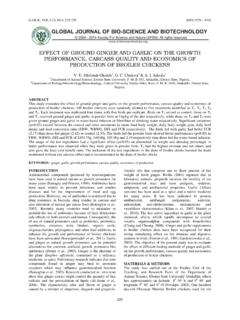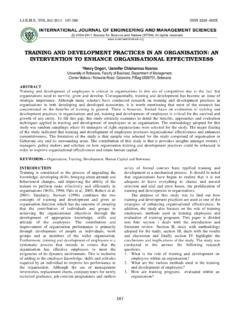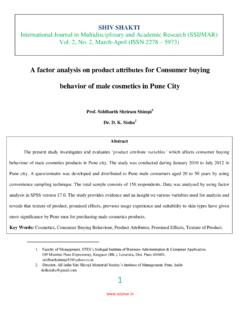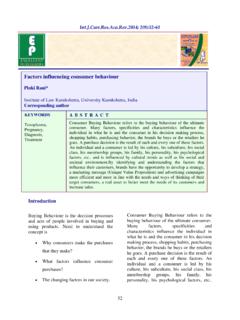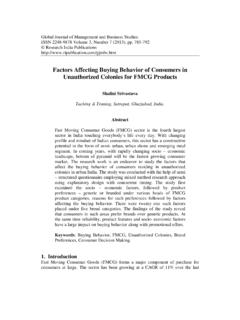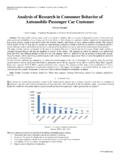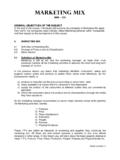Transcription of ROLE OF PACKAGING CUES ON CONSUMER BUYING …
1 , (1) 2013:61-69 ISSN 2229-600X61 ROLE OF PACKAGING cues ON CONSUMER BUYING behaviours uraj Kushe Shekhar, Raveendran P. of Management Studies, Kannur University, Kerala, IndiaABSTRACTP ackaging isan important element of modern lifestyle and branding process. Changing lifestyle and increasing self servicehas placed product package as a tool to stimulate impulse purchase and increase sales promotion. The present studyidentified chocolate packagingcues influencing BUYING decisions of young consumers inKannur District,Kerala State, cross sectional descriptive research with convenient sampling technique elicited data from 240 test,Shapiro-Wilk test,Kruskal Wallis test, Mann-WhitneyUtests were used to interpret the statistics showed that chocolate PACKAGING had significant influence in purchase pattern andfemales differed significantly with respect to variablesnamed Ingredients & Manufacturing unit s address.
2 Quality , Material , Ingredients & Manufacturing unit s address weresignificantacrosscertainage groups of the respondents. Brand name , Material and Ingredients differed significantly across , it was concluded that theinformationalelements on packages positively influencedpurchase decisions than visual elements as far as lowinvolvement purchasecategories(chocolates) were :Chocolates, CONSUMER Behaviour, PACKAGING , is considered as an important component ofmarketing. Earlier PACKAGING was regarded as a mereprotective tool but today it is considered as an importantcomponent of marketing process. Nowadays PACKAGING isoften argued as the fifth P of the marketing wasPilditch (1961) who was the first to propose packsas the silent salesman . Richardson et al. (1994) identifiedpackages as product related but with extrinsic (1991)extended Pilditch s(1961)views, describinggood PACKAGING as far more than a salesman but a flag ofrecognition and a symbol of values.
3 Underwood (2003)claimed that packages were having intrinsic or extrinsicattributes based on certain features they ,Bruce and Studd(2003) further stated that today,the packmust come alive at the pointof purchase, in order torepresent the and Tranchell (2007)described that the world loved evenmentioned that nine out of ten people liked chocolates andthe tenth person always lied. They added that chocolatecould makeeveryone smile even etal. (2010) opinedthat out of the many secondary factorsaffecting CONSUMER s BUYING decisions of chocolates, PACKAGING was found to be equally important. Packagingin the chocolate industry is therefore critical particularlywhen positioned to young consumers. Today packages aredesigned to appeal different occasions, demand todifferent social groups and even distinguish betweendifferent brands.
4 Based on the results from previousresearch studies, this paper makes an attempt to identifythechocolate PACKAGING cues influencing BUYING decisionsof young consumersacross three demographic variablesnamely sex, age and REVIEWP ackaging plays an imperative role in marketing of anygoods. PACKAGING communicates the marketing objectiveof a specific product to the CONSUMER . As per Sonsino(1990), package design variables mainly constituted thefollowing components: colour, typography, pictures,shape, size, and material. Sauvage (1996) examined theimportance of shape in creating an image about theproduct and the brand. He also mentionedthat the materialof a package affected CONSUMER thought evenidentified that carefully chosen typography was importantfor readability. Underwood et al.
5 (2001)noted thatpictures on packagesincreased learning and wereconsidered more vivacious stimuli than verbalexplanations. Underwood (2003) even suggested thatconsumers linked meanings to the package colours in threedifferent groups namely the physiological , the cultural ,and the associational . Healsoexplained the significanceof sizeof the packagewhen considering the visibility of apackage and the information it displayed. Rigaux (1982)explained that the combined effects of brand names andbrand PACKAGING increased consumers' perceptions (1948) identified the importance of eyeappeal, the attractiveness, and the stimulus to impulsebuying which transparent wrapping films (Cellophane)could impart to CONSUMER goods. The author suggestedthat if properly executed, prepackaging couldrevolutionize the marketing of fresh fruits, vegetables,meats etc.
6 He suggested that this could lower handlingcost, reduce waste and increase (1988) identified five key areas in packagingwhich gave value-added functions for CONSUMER . Theauthor suggested that PACKAGING could add value throughbrand identification, serve as the advertisement at thepoint-of-sale, help the CONSUMER transport the product,improve at-home storage, add value by providing taskassistance etc. Gelperowic& Beharrell (1994) in theirstudy investigated the product and PACKAGING factorsaffecting purchase decisions by mother and child, withRole of PACKAGING cues onconsumer BUYING behaviour62special reference to healthy food products. It wasperceived that in terms of a healthy food products, thepackaging had to be nice-looking and appealing tochildren to make them eat it and to assure mothers thatthey would eat it; but in order to make the mother buy it inthe first place, without any guilt feeling, the healthy aspectof the product was needed to be signaled on the , healthy food products had to be fun and attractiveto appeal to children and had to show mothers theirhealthy et al.
7 (1996) explored the relative impact ofpackage coupons on profit. The results suggested that, ofthevarious package coupons, on-pack coupons lead to thehighest impact on profits. Further, while peel-offs lead to ahigher market share than in-packs, because in-packsstimulated repurchase among earlier buyers, they lead tohigher profits than peel-offs; though only for & Robben (1997) investigated the effectof the degree of deviation of coffee packages onconsumers' attention and categorization. Findingssuggested that the more a package redesign deviated fromthe existing package design in a product category, themore product attention was induced. An inverted U shapedrelationship existed between the discrepancy of newproduct packages in a product category with the existingpackage and the evaluation of the product.
8 Furthertheauthors conveyed that a trade-off has to be made bymanufacturers and package designers between the abilityof modified packages to draw attention and to avoidnegative package evaluations of such packages. Moderatepackage deviations of modified packages looked to givethe best trade-off with regard to drawing attention andcreating favorable CONSUMER evaluations of a well-established & Mackln (1998) identified theassociation between brand names and accompanyingvisuals (pictures) onconsumer packaged goods. It wasseen that when visuals were associated with a brand name,then memory for the brand increased. It was also foundthat memory was greater for brand names that were prior-associated in consumers memory than for family andnovel brand names. Further it was found that packagedgoods having visual cues that reinforced the respectivebrand names stimulated greater memory for the brandnames than packaged goods having name-unassociatedvisual cues and/or no visual cues .
9 Attribute-associatedvisual cues facilitated greater memory than attribute-unassociated visual cues .The findings were in congruencewith associative network et al. (1998) illustrated how anunderstanding of CONSUMER models, psychologicalprocesses and the appropriate use of marketing researchtechniques could help in the design of food PACKAGING andlabel copy to provide a company with a competitiveadvantage. The authors highlighted that an understandingof the CONSUMER was central to the successof a & Ozanne (1998) proposed a normativeframework to direct the design of effective communicationin product PACKAGING . The authors suggested that a set ofnorms ( the norm of truthfulness, the norm of sincerity,the norm ofcomprehensibility and the norm of legitimacy)could direct the complex task of designing good productpackaging.
10 The key finding from this study was arecurring theme of duplicity in relationships betweenconsumers and & Brewer (2000) described the concept of brainlaterality in processing the information (visual & verbal)under conditions of fast perception with respect to productpackages. The authors explored the relationship betweenthe positioning of copy (verbal) and pictures on differentsides of a pack, and the recall of those elements. Theresults showed that to maximize recall, words should beon the right-hand sides of packs, pictures should be on theleft. The results confirmed the asymmetry of perception ofelements of & France (2001) examined how the graphicalcomponent of the package influenced CONSUMER beliefseven when the verbal component of the package providedaccurate product attribute information.

